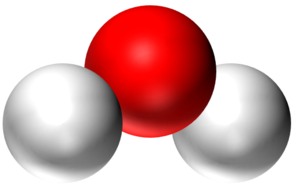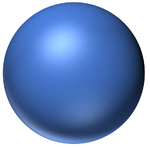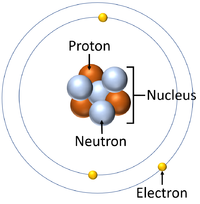Difference between revisions of "Particle"
(→Examples) |
|||
| Line 4: | Line 4: | ||
===About Particles=== | ===About Particles=== | ||
| − | |||
: [[Particle]]s are often made of other, smaller, [[particle]]s. | : [[Particle]]s are often made of other, smaller, [[particle]]s. | ||
| + | : [[Particle]]s are usually shown as round in shape but may be made of smaller [[particle]]s making their shape a combination of the shapes of other [[particle]]s stuck together. | ||
===Examples=== | ===Examples=== | ||
| Line 18: | Line 18: | ||
| style="height:20px; width:300px; text-align:center;" |The [[atom]] is made of smaller [[particle]]s called [[Proton]]s, [[Neutron]]s and [[Electron]]s. | | style="height:20px; width:300px; text-align:center;" |The [[atom]] is made of smaller [[particle]]s called [[Proton]]s, [[Neutron]]s and [[Electron]]s. | ||
|} | |} | ||
| + | |||
| + | ==Key Stage 4== | ||
| + | ===Meaning=== | ||
| + | A [[particle]] is a small piece of [[matter]] | ||
| + | |||
| + | ===About Particles=== | ||
| + | : [[Particle]]s are often made of other, smaller, [[particle]]s. | ||
| + | : [[Particle]]s are usually shown as round in shape but may be made of smaller [[particle]]s making their shape a combination of the shapes of other [[particle]]s stuck together. | ||
| + | |||
| + | ===Examples=== | ||
| + | {| class="wikitable" | ||
| + | |- | ||
| + | |[[File:WaterMolecule.png|center|300px]] | ||
| + | |[[File:DaltonModelAtom.png|center|150px]] | ||
| + | |[[File:AtomDiagram.png|center|200px]] | ||
| + | |- | ||
| + | | style="height:20px; width:300px; text-align:center;" |A [[water]] [[molecule]] is a [[particle]] made of 1 [[Oxygen]] [[atom]] and two [[Hydrogen]] [[atom]]s. | ||
| + | | style="height:20px; width:300px; text-align:center;" |An [[atom]] is a [[particle]]. | ||
| + | | style="height:20px; width:300px; text-align:center;" |The [[atom]] is made of smaller [[particle]]s called [[Proton]]s, [[Neutron]]s and [[Electron]]s. | ||
| + | |} | ||
| + | |||
| + | ==Key Stage 5== | ||
| + | ===Meaning=== | ||
| + | '''Particle''' is a general term used to describe a 'small' unit of [[matter]]. | ||
| + | |||
| + | ===About Particles=== | ||
| + | : The term '''particle''' may be used to describe [[object]]s as large as several billion [[atom]]s (as in a [[soot]] [[particle]]) or as small as a smallest possible unit of [[matter]] known as a [[Fundamental Particle|fundamental particle]]. | ||
| + | : In [[physics]] the term '''particle''' is used: | ||
| + | :*On larger scales to simplify calculations of the motions of [[object]]s by approximating them to be round with an even distribution of [[mass]] | ||
| + | :*On large groups of [[object]]s at smaller scales for calculations of bulk properties by approximating them to be [[Point Particle|point]]s with negligible [[Volume (Space)|volume]]. | ||
| + | :*On [[atom]]ic and [[subatomic Particle|subatomic]] scales to name units of [[matter]] which are often repeated in nature (eg. the [[proton]] is a repeating unit of [[matter]] found in all [[atom]]s). | ||
Revision as of 10:06, 18 July 2019
Contents
Key Stage 3
Meaning
A particle is a small piece of matter
About Particles
- Particles are often made of other, smaller, particles.
- Particles are usually shown as round in shape but may be made of smaller particles making their shape a combination of the shapes of other particles stuck together.
Examples
| A water molecule is a particle made of 1 Oxygen atom and two Hydrogen atoms. | An atom is a particle. | The atom is made of smaller particles called Protons, Neutrons and Electrons. |
Key Stage 4
Meaning
A particle is a small piece of matter
About Particles
- Particles are often made of other, smaller, particles.
- Particles are usually shown as round in shape but may be made of smaller particles making their shape a combination of the shapes of other particles stuck together.
Examples
| A water molecule is a particle made of 1 Oxygen atom and two Hydrogen atoms. | An atom is a particle. | The atom is made of smaller particles called Protons, Neutrons and Electrons. |
Key Stage 5
Meaning
Particle is a general term used to describe a 'small' unit of matter.
About Particles
- The term particle may be used to describe objects as large as several billion atoms (as in a soot particle) or as small as a smallest possible unit of matter known as a fundamental particle.
- In physics the term particle is used:
- On larger scales to simplify calculations of the motions of objects by approximating them to be round with an even distribution of mass
- On large groups of objects at smaller scales for calculations of bulk properties by approximating them to be points with negligible volume.
- On atomic and subatomic scales to name units of matter which are often repeated in nature (eg. the proton is a repeating unit of matter found in all atoms).


